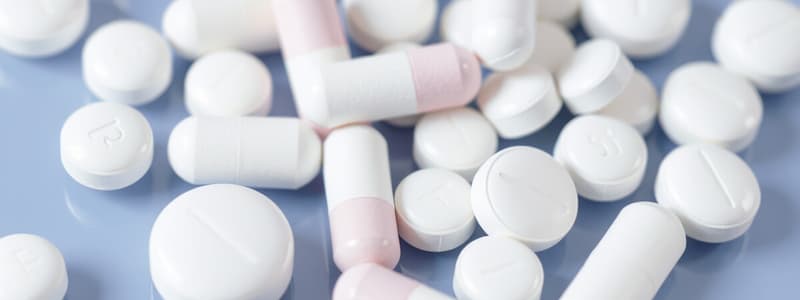Podcast
Questions and Answers
What is the trade name of Aminophylline?
What is the trade name of Aminophylline?
- Theophylline
- Phyllocontin (correct)
- Atrovent
- Ventolin
What is the generic name of the drug?
What is the generic name of the drug?
Aminophylline
What is the therapeutic classification of Aminophylline?
What is the therapeutic classification of Aminophylline?
Bronchodilators
What is the pharmacologic classification of Aminophylline?
What is the pharmacologic classification of Aminophylline?
What are indications for using Aminophylline?
What are indications for using Aminophylline?
What is the action of Aminophylline?
What is the action of Aminophylline?
Which of the following are side effects of Aminophylline? (Select all that apply)
Which of the following are side effects of Aminophylline? (Select all that apply)
What assessments should be performed for a patient on Aminophylline?
What assessments should be performed for a patient on Aminophylline?
What is important about the implementation of Aminophylline?
What is important about the implementation of Aminophylline?
What client teaching should be provided for patients using Aminophylline?
What client teaching should be provided for patients using Aminophylline?
Flashcards are hidden until you start studying
Study Notes
Aminophylline Overview
- Trade name: Phyllocontin
- Generic name: Aminophylline
- Therapeutic classification: Bronchodilators
- Pharmacologic classification: Xanthines
Indications
- Used for long-term control of reversible airway obstruction due to asthma or COPD.
- Enhances diaphragmatic contractility.
- Unlabeled use as a respiratory and myocardial stimulant for premature infant apnea.
Mechanism of Action
- Inhibits phosphodiesterase, leading to increased tissue levels of cyclic adenosine monophosphate (cAMP).
- Elevated cAMP levels result in bronchodilation, CNS stimulation, positive inotropic and chronotropic effects, diuresis, and gastric acid secretion.
- Aminophylline is a salt of theophylline, releasing free theophylline upon administration.
Therapeutic Effects
- Principal effect: Bronchodilation.
Side Effects
- CNS: seizures, anxiety, headache, insomnia, irritability.
- Cardiovascular: arrhythmias, tachycardia, angina, palpitations.
- Dermatological: rash.
- Gastrointestinal: nausea, vomiting, anorexia.
- Neurological: tremor.
Assessment
- Monitor blood pressure, pulse, respiratory status before and during therapy.
- Ensure proper oxygen therapy during acute asthma attacks.
- Track intake and output to detect changes in diuresis or fluid overload.
- Assess patients with cardiovascular history for chest pain and ECG changes.
- Resuscitative equipment should be available.
- Conduct pulmonary function tests periodically.
- Monitor ABGs, acid-base status, and fluid/electrolyte balance if on parenteral therapy.
- Toxicity Monitoring: Regularly check drug levels, especially with high doses.
- Therapeutic range: 10-15 mcg/mL for asthma; 6-14 mcg/mL for apnea of prematurity. Levels above 20 mcg/mL indicate toxicity.
- Symptoms of toxicity include: anorexia, nausea, vomiting, confusion, tachycardia, seizures.
Implementation
- Administer around the clock to ensure therapeutic plasma levels.
Client Teaching
- Encourage adequate fluid intake (at least 2000 mL/day) to reduce airway secretion viscosity.
- Advise against using OTC cough, cold, or breathing medications without consulting a healthcare professional to prevent increased side effects and arrhythmias.
- Smoking cessation is encouraged; changes in smoking may require dose adjustments.
- Suggest minimizing the intake of xanthine-containing foods.
Studying That Suits You
Use AI to generate personalized quizzes and flashcards to suit your learning preferences.


